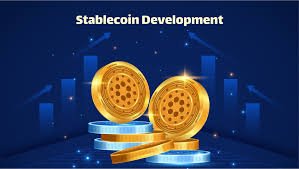Stable Coin Development: Key Tools and Tech Stack
The increasing adoption of blockchain technology and cryptocurrencies has catalyzed the rise of stablecoins—digital assets pegged to a stable value like fiat currencies or commodities. Unlike traditional cryptocurrencies such as Bitcoin or Ethereum, stablecoins are designed to minimize volatility, making them more practical for everyday use, cross-border payments, and decentralized finance (DeFi) applications. Developing a stablecoin requires not just smart contract expertise but a well-curated set of tools and technologies to ensure security, scalability, compliance, and interoperability. In this blog, we will explore the key tools and tech stack essential for stablecoin development, covering blockchain platforms, smart contract languages, development frameworks, oracles, security tools, APIs, and testing environments.
1. Choosing the Right Blockchain Platform
The foundational decision in stablecoin development is selecting the blockchain platform. The choice influences scalability, transaction costs, and user base.
Ethereum: The most widely used blockchain for stablecoins due to its mature ecosystem and extensive DeFi integration. ERC-20 and ERC-1400 standards are commonly used.
Binance Smart Chain (BSC): Offers faster and cheaper transactions than Ethereum, making it popular for cost-effective stablecoin deployments.
Solana: Known for high throughput and low latency, suitable for real-time applications.
Polygon: A Layer 2 solution for Ethereum that reduces gas fees while maintaining interoperability.
TRON: Offers scalability and speed, widely used in Asia.
Algorand and Stellar: These platforms are also used for stablecoin issuance due to their speed, compliance readiness, and asset tokenization features.
2. Smart Contract Languages
Stablecoins rely on smart contracts to manage issuance, redemption, and compliance.
Solidity: The dominant language for Ethereum-based stablecoins.
Vyper: A Pythonic smart contract language designed for security.
Rust: Used in platforms like Solana and NEAR.
Move: Language for Aptos and Sui blockchains, providing better asset safety.
Clarity: Used in Stacks for Bitcoin-based smart contracts, focused on predictability.
3. Stablecoin Types and Design Models
Before development, understanding the type of stablecoin is critical:
Fiat-collateralized (e.g., USDC, USDT): Backed by reserves in a 1:1 ratio.
Crypto-collateralized (e.g., DAI): Over-collateralized by crypto assets.
Algorithmic (e.g., Frax, TerraClassicUSD): Maintains peg using algorithms and smart contracts.
The type influences the smart contract logic, oracle dependency, and audit needs.
4. Development Frameworks and Toolkits
Truffle Suite: Popular for Ethereum development; includes Truffle, Ganache, and Drizzle.
Hardhat: A modern development environment for Ethereum with advanced testing and debugging features.
Anchor: Rust-based framework for Solana development.
Brownie: A Python-based framework for Ethereum smart contract development.
NEAR SDK: Used for writing smart contracts in Rust for NEAR Protocol.
5. Oracles and Price Feeds
Stablecoins, especially algorithmic and crypto-collateralized ones, need external data to function accurately.
Chainlink: The most trusted decentralized oracle for delivering off-chain data.
Band Protocol: Fast and efficient oracle system.
Pyth Network: Solana-based, real-time price feeds for high-frequency use cases.
Tellor: Decentralized oracle system with crypto-incentivized validators.
6. Identity and Compliance Tools
Regulatory compliance is crucial for fiat-collateralized stablecoins. Integrations may include:
Chainalysis / TRM Labs: For AML and KYC compliance monitoring.
Civic / Shyft: Decentralized identity management.
Fireblocks / Copper: For institutional-grade custody and compliance tools.
7. Wallet Integration and SDKs
Web3.js / Ethers.js: JavaScript libraries to interact with Ethereum.
Solana Web3.js: For Solana-based wallet interactions.
Wallet SDKs: From MetaMask, Trust Wallet, Phantom, etc., for user access.
Firebase + Web3: For building hybrid Web2-Web3 stablecoin apps.
8. Backend and API Infrastructure
Moralis: Simplifies backend development for dApps.
Alchemy / Infura: Blockchain node infrastructure providers.
The Graph: Indexes blockchain data and offers GraphQL APIs.
Pocket Network: Decentralized infrastructure for RPC endpoints.
9. Security Auditing and Testing Tools
Security is paramount for stablecoin contracts as they handle large volumes of assets.
MythX / Slither: Automated smart contract analysis tools.
Certik / Quantstamp: Professional security auditing services.
OpenZeppelin: Secure smart contract libraries.
Echidna / Manticore: Fuzzing and symbolic execution tools for in-depth testing.
10. Stablecoin Minting and Burning Mechanics
Every stablecoin needs mechanisms for minting and burning:
Minting: Triggered upon collateral deposit or fiat backing confirmation.
Burning: Initiated when stablecoins are redeemed or collateral is withdrawn.
These are implemented via smart contracts with strict role management and access control.
11. Frontend Frameworks for UI/UX
React.js / Next.js: Popular frameworks for building responsive interfaces.
Tailwind CSS / Bootstrap: For rapid UI development.
Web3Modal / RainbowKit: For wallet connection interfaces.
12. Cross-Chain and Interoperability Tools
LayerZero / Wormhole / Axelar: Facilitate cross-chain stablecoin transfers.
IBC (Inter-Blockchain Communication): Used in Cosmos-based chains.
13. Token Standards and Governance
ERC-20 / ERC-1400 / ERC-4626: Different standards depending on required features.
DAO Governance Tools: Aragon, Snapshot, Gnosis Safe for decentralized governance of stablecoin policies.
14. Deployment and Monitoring Tools
Tenderly: Real-time monitoring and debugging of smart contracts.
Dune Analytics: Custom dashboards for tracking stablecoin metrics.
Blockscout / Etherscan: Block explorers for transparency.
15. Hosting and Cloud Infrastructure
IPFS / Filecoin: For decentralized storage of metadata and legal documents.
AWS / Google Cloud / Azure: For scalable Web2-backend support.
Conclusion
Developing a stablecoin in 2025 demands more than just coding a smart contract. It requires a comprehensive tech stack and deep understanding of blockchain protocols, compliance frameworks, and user-centric design. From selecting the right blockchain to ensuring secure oracle integration and regulatory adherence, every decision shapes the stability, adoption, and scalability of your digital asset. Leveraging modern tools and frameworks can drastically reduce development time while increasing the reliability and compliance-readiness of the stablecoin. As demand for reliable digital assets grows, a well-structured tech stack will remain the cornerstone of any successful stablecoin project.
